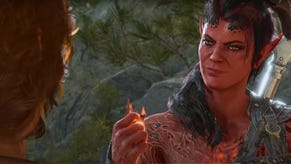Digital snowflakes: The EG Expo Indie Games Arcade
Amongst blinking lights, soul-shredding bass and the mega-publisher bombast of the Eurogamer Expo there is a beacon of calm. Stace Harman visits the Indie Games Arcade with a pocket full of high hopes.
Here stands a monument to dreams nurtured and realised, a retreat to which those in need of a soothing of spirit or quieting of mind gravitate towards for respite from the frazzling hubbub. It is an oasis of redemption, with a multitude of balms available in all manner of shapes, colours and flavours that many a gamer and industry folk alike flock to for gentle revitalisation.
And by happy coincidence, not too far from this alcohol-stocked bar is the Indie Games Arcade.
Inexplicably, the Indie Games Arcade sits adjacent to the garish rambunctiousness of the Just Dance 3 stand at which people flail about as if possessed, though I’m informed by one eager punter that this is called “dancing”. As an aside, it should be obvious that mixing this strange physical activity with gaming is a fool’s errand: it’ll never catch on. Next you’ll be suggesting that an exercise-based videogame could sell more units week after week after week than a conventional game.
Fortunately, away from the numbing effects of alcohol and the frightening effects of “dancing” there sit a multitude of games with the power to provoke and excite. Games that, aside from their indie origins, have little in common with one another or indeed with anything else on the show floor – in fact, in some cases: they have little in common with anything else you’ve seen anywhere.
That’s why I’m here and, happily, why a pleasing number of other people are here too: to spend time with games that, for the most part, look and feel different to other games and to suss out what each of these digitally unique titles has to offer.
With close to 20 titles in the Indie Games Arcade there’s a plenty of variation in visual flair, mechanical polish and game play complexity. Some bear recognisable traces of their influences, others have instantly fathomable goals and one offers up its heart to be manipulated or discarded.
The following, then, is a round-up not necessarily of the best titles on show - drawing comparisons between some of these titles would be so irrelevant as to waste everyone’s time – instead, this is a round-up intended to represent the different styles, approaches and experiences available in this little slice of gaming nirvana.
This game provides the most out-and-out fun of those in the indie arcade. Pineapple Smash Crew plays as a fast-paced team-shooter in which you control your mech-suited, cuboid-headed squad members as one close-knit unit. The ability to promote any team member to leader and equip each with a different grenade or support pack leads to switching point-men on the fly as you strafe and shoot your way round a multitude of derelict space craft, searching for loot and valuable pick-ups.
Team members that survive each expedition gain experience and level-up, but those that don’t make it are replaced by new recruits between levels. Frequent dialogue text pops up on screen and lends each soldier ample enough personality that you feel a slight twinge of regret when one of them dies. The old school art style nods to the game’s many inspirations, of which developer Edwards lists Alien Breed, Cannon Fodder, Chaos Engine, Toejam and Earl and Speedball 2 amongst others. It sounds good, because it is.
Pineapple Smash Crew will be available as a PC download title in the next few months, ports to other platforms will be considered once the game has launched.
Fotonica has the hypnotic cadence of a visual music-equaliser rendering a graphical representation of your favourite song, alongside single-button game play that both promotes its simplicity and belies its challenge. The abstract duotone wireframe environments present platforms built for speed-runs, negotiated in first-person. The duration of a single button press controls the length of a jump whilst pressing the button again in mid-air facilitates a more rapid descent. And a combination of the two must be mastered to ensure smooth traversal of platforms punctuated by a series of gaps requiring anything from several short, sharp, hops to mammoth near-leaps-of-faith.
Purple collectibles add a score attack element and, where the path is split over multiple vertical levels, often provide clues to the optimum route. Fotonica consists of five levels, followed by one procedurally generated endless level, plus achievements, two-player split screen and cross-platform leader boards. It also invites lazy comparisons to a handful of games; none of which shall be made here.
Fotonica is available DRM-free for MAC and PC on a pay-what-you-want basis from the game’s website
Molecats are simpletons, so we are told. As such, it falls to you to mastermind their navigation of underground tunnels. You must guide the molecats through a series of interconnected but discreet rooms which can be twisted 90 degrees at a time to alter the path that the ceaselessly marching, happy-go-lucky molecats will take.
Collect mushrooms for bonus points, rescue other hapless molecats along the way and encounter tiles with special properties: such as those that are too dark to traverse without a torch, switches that automatically twist tiles when the molecats pass them and secret areas that require a sharp mind to reach or the occasional smidgen of luck to stumble into. The beguiling art style depicting grinning molecats and spaghetti-junction paths hewn through the rock, will imprint itself on your eyelids when you’re trying to sleep and sits alongside a soundtrack at the very edge of joyously catchy and infuriatingly infectious.
Molecat Twist will be available soon for PC.
It’s genuinely difficult to write much about At a Distance without spoiling the fundamental experience of playing it. Suffice to say, it is a local-two-player-co-op first-person puzzler in which communication is genuinely essential to progress – or indeed to figure out what’s going on. As much time is spent discussing the path forward, referring to each other’s screens and developing an understanding of the geometry of the environment as is spent actually traversing it.
Cavanagh, who is also responsible for puzzle-platformer VVVVVV, is reticent to say much of anything about the game for the fear of detracting from the experience. Were he attempting to promote its launch that could be a problem but a number of things are yet to be decided about his latest project: including if it will even see a release as a standalone title, if it might be developed further or perhaps whether it might be applied conceptually to a different project all together.
What is apparent, though, is that as a nominee for Eurogamer’s official Game of the Show award it bears keeping track of, even if the 30-minute run-through at the expo was one of the few places you can expect to see it. Much like catwalk fashion informs designs on the high street, don’t be surprised if a game using At a Distance’s concept appears before too long, it could, for example, be a perfect fit for a split-screen PSN or XBLA game.
At a Distance is a finished product but has not yet been confirmed for release.
Being stumped by a game is a curious thing: sometimes when we feel we’ve hit a wall, we’ll turn to the internet for a helping hand or even a cheat, happy to seek assistance where none is offered in-game. However, when confronted with a game full of logical, cog-and-heart-based puzzles that stand between us and an unfolding narrative and told that we can skip any level, at any time - even all the way through to the end of the game if we just wish to see how the story plays out - we hesitate. Stubborn pride insists that where there is no unfair difficulty spike or perceived ‘design flaw’ we persevere because it can be done and so we should do it properly.
And that’s the brilliance of Alan Hazelden’s, These Robotic Hearts of Mine. The sentence of narrative displayed between each puzzle tells the story of a boy and a girl, friends but perhaps wishing to be more, who find a robot in the woods and...well, I’ll say no more: not because I am conscious of upsetting your delicate sensibilities with spoilers, you understand, but because I don’t make it past level nine and, frankly, my non-robotic heart refuses to let me skip through a game so charmingly designed.
These Robotic Hearts of Mine is a browser-based game expected for release by the end of 2011
A handful of iOS games also grace the arcade, with honourable mentions going to the already-available Greedy Bankers, Hard Lines and Tiny Invaders; each of which feature their own quirks and charming traits on iPad, iPhone and iPod Touch.
The Eurogamer Expo Indie Games Arcade offers a cerebral, joyous and personality-filled experience to all those that visit and whispers affirmations about an industry that is so often preoccupied with who can shout the loudest.
Next door, the Just Dance 3 podium dancers entice another group of patrons to mimic someone else’s moves and to think little about the mindless joy of dancing to another person’s tune. The juxtaposition with the Indie Games Arcade is delicious.














.jpg?width=291&height=164&fit=crop&quality=80&format=jpg&auto=webp)



